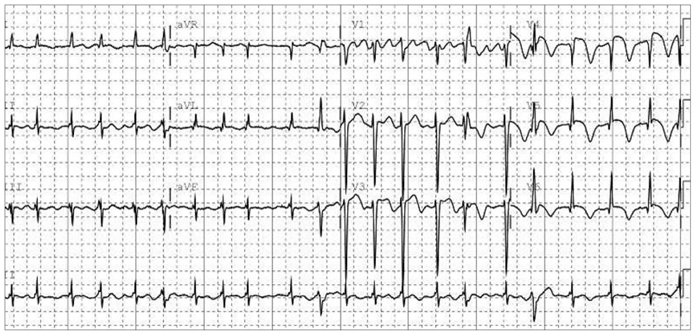J Clin Neurol.
2010 Sep;6(3):152-155. 10.3988/jcn.2010.6.3.152.
Takotsubo Cardiomyopathy Following Cerebral Infarction Involving the Insular Cortex
- Affiliations
-
- 1Department of Neurology, Ewha Womans University School of Medicine, Seoul, Korea.
- 2Department of Neurology, Konkuk University School of Medicine, Seoul, Korea. serein@kuh.ac.kr
- 3Department of Cardiology, Konkuk University School of Medicine, Seoul, Korea.
- KMID: 1462852
- DOI: http://doi.org/10.3988/jcn.2010.6.3.152
Abstract
- BACKGROUND
Takotsubo cardiomyopathy is characterized by clinical features similar to those of acute myocardial ischemia, but without angiographic evidence of obstructive coronary artery disease. We present a patient with takotsubo cardiomyopathy following acute infarction involving the left insular cortex.
CASE REPORT
A 52-year-old man was admitted with acute infarction of the left middle cerebral artery territory and acute chest pain. Acute myocardial infarction was suspected because of elevated serum troponin levels and hypokinesia of the left ventricle on echocardiography. However, a subsequent coronary angiography revealed no stenosis within the coronary arteries or ballooning of the apical left ventricle.
CONCLUSIONS
We postulated that catecholamine imbalance due to the insular lesion could be responsible for these interesting features.
Keyword
MeSH Terms
Figure
Reference
-
1. Pilgrim TM, Wyss TR. Takotsubo cardiomyopathy or transient left ventricular apical ballooning syndrome: A systematic review. Int J Cardiol. 2008. 124:283–292.
Article2. Prasad A, Lerman A, Rihal CS. Apical ballooning syndrome (Tako-Tsubo or stress cardiomyopathy): a mimic of acute myocardial infarction. Am Heart J. 2008. 155:408–417.
Article3. Kume T, Kawamoto T, Okura H, Toyota E, Neishi Y, Watanabe N, et al. Local release of catecholamines from the hearts of patients with tako-tsubo-like left ventricular dysfunction. Circ J. 2008. 72:106–108.
Article4. Bybee KA, Prasad A, Barsness GW, Lerman A, Jaffe AS, Murphy JG, et al. Clinical characteristics and thrombolysis in myocardial infarction frame counts in women with transient left ventricular apical ballooning syndrome. Am J Cardiol. 2004. 94:343–346.
Article5. Parodi G, Del Pace S, Carrabba N, Salvadori C, Memisha G, Simonetti I, et al. Incidence, clinical findings, and outcome of women with left ventricular apical ballooning syndrome. Am J Cardiol. 2007. 99:182–185.
Article6. Wittstein IS, Thiemann DR, Lima JA, Baughman KL, Schulman SP, Gerstenblith G, et al. Neurohumoral features of myocardial stunning due to sudden emotional stress. N Engl J Med. 2005. 352:539–548.
Article7. Akashi YJ, Nakazawa K, Sakakibara M, Miyake F, Musha H, Sasaka K. 123I-MIBG myocardial scintigraphy in patients with "takotsubo" cardiomyopathy. J Nucl Med. 2004. 45:1121–1127.8. Ueyama T, Kasamatsu K, Hano T, Yamamoto K, Tsuruo Y, Nishio I. Emotional stress induces transient left ventricular hypocontraction in the rat via activation of cardiac adrenoceptors: a possible animal model of 'tako-tsubo' cardiomyopathy. Circ J. 2002. 66:712–713.
Article9. Eickhoff SB, Lotze M, Wietek B, Amunts K, Enck P, Zilles K. Segregation of visceral and somatosensory afferents: an fMRI and cytoarchitectonic mapping study. Neuroimage. 2006. 31:1004–1014.
Article10. Colivicchi F, Bassi A, Santini M, Caltagirone C. Cardiac autonomic derangement and arrhythmias in right-sided stroke with insular involvement. Stroke. 2004. 35:2094–2098.
Article11. Ay H, Koroshetz WJ, Benner T, Vangel MG, Melinosky C, Arsava EM, et al. Neuroanatomic correlates of stroke-related myocardial injury. Neurology. 2006. 66:1325–1329.
Article12. Bagaev V, Aleksandrov V. Visceral-related area in the rat insular cortex. Auton Neurosci. 2006. 125:16–21.
Article13. Cheshire WP Jr, Saper CB. The insular cortex and cardiac response to stroke. Neurology. 2006. 66:1296–1297.
Article14. Banki NM, Kopelnik A, Dae MW, Miss J, Tung P, Lawton MT, et al. Acute neurocardiogenic injury after subarachnoid hemorrhage. Circulation. 2005. 112:3314–3319.
Article15. Mayer SA, Lin J, Homma S, Solomon RA, Lennihan L, Sherman D, et al. Myocardial injury and left ventricular performance after subarachnoid hemorrhage. Stroke. 1999. 30:780–786.
Article
- Full Text Links
- Actions
-
Cited
- CITED
-
- Close
- Share
- Similar articles
-
- Left Ventricular Thrombus Associated with Takotsubo Cardiomyopathy: A Cardioembolic Cause of Cerebral Infarction
- Acute Cerebral Infarction Following Takotsubo Cardiomyopathy Associated With Pneumothorax
- A Case of Reversal of Takotsubo Cardiomyopathy in Patient with Pheochromocytoma
- Takotsubo Cardiomyopathy Associated With Status Epilepticus
- Takotsubo Cardiomyopathy Induced after Postoperative ICU Care: Case Reports




